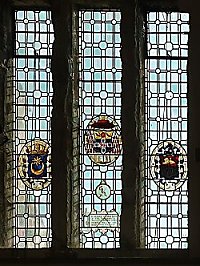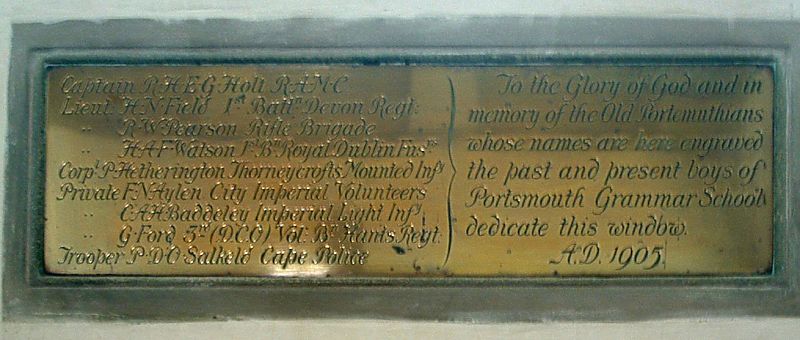Location
The window is in the south wall of the Navy Aisle. The plaque is beneath it (see Cathedral Plan).
OF THE PORTSMOUTH
GRAMMAR SCHOOL WHO
FOUGHT & FELL IN THE
BOER WAR 1899-1902.
Inscription (Plaque)
CAPTAIN R.H.E.G.HOLT R.ENG
Lieut H.N.FIELD 1st Battn DEVON REGT.
Lieut R.W.PEARSON RIFLE BRIGADE
Lieut H.A.F.WATSON 1st Bn ROYAL DUBLIN FUSILIERS
Corpl P.HETHERINGTON THORNEYCROFTS MOUNTED INFY
Private F.N.AYLEN CITY IMPERIAL VOLUNTEERS
Private C.A.H.BADDELEY IMPERIAL LIGHT INFANTRY
Private G.FORD 3rd (DCO) Vol Bn HANTS REGT
TROOPER P.D.O.SALKELD CAPE POLICE.
(Right)
To the Glory of God and in
memory of the Old Portemuthians
whose names are here engraved
the past and present boys of
Portsmouth Grammar School
dedicate this window
A.D.1905.
Further Information
"The star and crescent light in this window ... is ensigned with a naval crown. It must be remembered that when these windows were designed Portsmouth had not become a city and had no achievement of arms, that is to say no complete coat of arms. It was officially entitled to the shield only. The motto 'Heaven's Light our Guide' was registered in 1929 and the full achievement (arms, crest, badge and supporters) was granted by the Earl Marshal in 1970 as the result of a petition sponsored by the Portsmouth Museums Society. The special crown above the shield, although not part of a coat of arms, tells the stranger of Portsmouth's naval tradition. The centre light speaks of the School's foundation and founder.
Many visitors to the Cathedral ask why a cardinal's hat appears in an Anglican church. This refers to Cardinal Wolsey whose arms, borne also by Christ Church, Oxford, which he founded, are below. Wolsey possessed no arms by right, being the son of an Ipswich butcher, but he had no scruples about assuming marks of honour belonging to others. The silver engrailed cross on the black shield comes from the arms of the Uffords, once earls of Suffolk. The four blue leopards' faces belong to the De la Poles, also earls of Suffolk. Wolsey had no right to these, but simply annexed them. The red lion passant guardant refers to Pope Leo X who made Wolsey a cardinal. The top of the shield or chief is golden charged with a red rose to signify his service as a royal minister and two black choughs which are taken from the arms of his sainted namesake Thomas Becket. Beneath is an open book with the words 'Dominus illuminatio mea' – 'The Lord is my Light', a reference to the first verse of Psalm 27 and part of the escutcheon of Oxford University.
In a lozenge below is a staff around which is coiled a snake, crossed with a sword. In Greek and Roman mythology Asklepius or Aesculapius was the god of medicine and was usually represented as an old man with a staff around which was coiled a serpent – the symbol of wisdom; hence the staff and serpent has become a device widely adopted by physicians. This speaks of Dr. William Smith, the founder of Portsmouth Grammar School. The sword is the symbol of military power and is the artist's way of recording his status as physician to the garrison of the town. In 1717 the grand jury at Portsmouth quarter sessionsbemoaned the fact that the town had no grammar school and that the inhabitants were put to expense by having to send their children away for education. This no doubt influenced Dr. Smith in his capacity as an alderman, for he bequeathed property at East Standen in the parish of Arreton in the Isle of Wight to the dean and canons of Christ Church, Oxford, where he had received his education, in order that they might constitute and support a grammar school. Christ Church had to allow money to accumulate until 1750 before they had enough to erect a building in Penny Street. After this the School had a somewhat chequered existence, going through periods of prosperity and success, but others when education virtually ceased. However a complete reorganisation was proposed in 1873, when Canon Grant, the Vicar of Portsmouth, was mainly influential in reviving the School. New premises, now the Junior School, were opened in 1879 and success was assured and continuous. Christ Church was encouraged to continue its aid with money, and it retains its interest by appointing two governors and granting an award to the College exclusively for members of the School.
In the right-hand light are the arms of Dr. Smith. It is interesting to note that in Lilley and Everitt's history of the church this coat of arms is placed in the centre light with Christ Church on the right. This is the correct arrangement because the founder of the School was obviously the most important figure in the events which this window records. Further, the descriptive lozenge with the staff of Aesculapius and the sword would then apply correctly to Dr. Smith. This window was damaged during the 1939-45 war and had to be repaired afterwards. This repair was carried out in a way which may be artistically satisfying but is heraldically wrong.
The Smith arms formed the basis of an achievement of arms granted to the School in 195744 which shows the relationship with the founder, his college and the city of Portsmouth.
Thus the memorial of the nine Old Portmuthians who died tells heraldically the story of the foundation of their school."
[Portsmouth Paper No. 27, "The Windows of Portsmouth Cathedral" by E.K. Barnard.]




